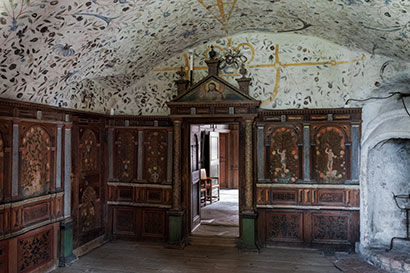
The Vasa family
Gripsholm was originally built as a secure fortress during a turbulent time, but it was also more than that. The castle was also the royal family's favourite residence. They lived here for much of the time when their children were young.
At Gripsholm, you can get a sense of what life was like at the Vasa court. The main structure of the old castle still exists: four fortified towers with residential wings in between. As the royal power was strengthened and external threats grew fewer, the castle was gradually furnished with an increasing emphasis on comfort.
"Here, there was less risk of epidemics…"
Gustav Vasa may have been feared as a king, but family was important to him. He and Margareta Leijonhufvud did not send their children away to other people's courts, as was common among the nobility at the time, and instead had them brought up at their own court. Having their children live at Gripsholm, with its rural surroundings and fresh air, was part of this. Here, there was less risk of epidemics and the children could eat fresh fruit and vegetables from the castle's gardens.
The large farm with its fields, forests and fishing waters provided most of what was needed. The castle's cows were tended to by 22 milkmaids, and every year many barrels of honey were delivered from the hives to meet the castle's needs. The capable Margareta Leijonhufvud was closely involved in the castle's housekeeping.
"Take good care to ensure that they are well supplied with clothing and other essentials…"
In his surviving letters, the otherwise feared king appears to be something of a doting father who went to great lengths to protect his children if they showed signs of a cold, and tried in vain to prevent them from eating too many sweet treats. If they were to go travelling, he sent careful instructions: "Take good care to ensure that they are well supplied with clothing and other essentials, as the cold and the frost are quite dangerous." This diligence produced good results. Of the king's eleven children, nine of his 'plucky heirs' survived to adulthood – quite an achievement, considering how high the infant mortality rate was at the time.
"… their own dance master who taught them to walk, stand and conduct themselves like princes."
Gustav Vasa was well aware of his own lack of education, and therefore ensured that no expense was spared when it came to his children's upbringing. His daughters were taught everything required of fine ladies, from 'useful household occupations' and running a large household, to sewing and German. They also learnt to dance, ride and play music. His sons' education was even more extensive. They were drilled in Latin, German and French. They were taught geography, rhetoric, theology and history, as well as more practical skills such as horse riding and martial arts. But they also had their own dance master who taught them to walk, stand and conduct themselves like princes. In addition, they were taught music and art. Over time, they developed an interest in art, architecture and gardening, which is still reflected at Gripsholm today.
Top image: King Gustav I and Margareta Leijonhufvud walking in the castle grounds. Their costumes are modelled on original portraits at the castle, and will be worn at events during the 2023 Vasa anniversary at Gripsholm. Photo: Raphael Stecksén/Royalpalaces.se

The Grip Tower. The fortified Gripsholm Castle also became a beloved home for the Vasa family. During certain periods, they spent more time here than at the Tre Kronor Palace in Stockholm. Photo: Raphael Stecksén

Correspondence between the couple reveals that Gustav Vasa was a dedicated and sometimes anxious father. This portrait of Gustav Vasa can be seen in the Vasa Apartment at Gripsholm Castle. Photo: Bruno Ehrs

Click on the image to start the tour of the room in 360°. Gustav Vasa's children received a princely education, including in dance, music and not least art. This interest in art and architecture can be seen in Duke Karl's Chamber, which was decorated following the latest European fashions. Photo: Sanna Argus Tirén

Gustav Vasa's consort Margareta Leijonhufvud managed the Gripsholm estate. She was in charge of the household and the self-sufficient farm, and managed travel between the palaces. She also gave birth to ten children during a period of thirteen years. This portrait of the queen can be seen in the Vasa Apartment at Gripsholm Castle. Photo: Nationalmuseum










